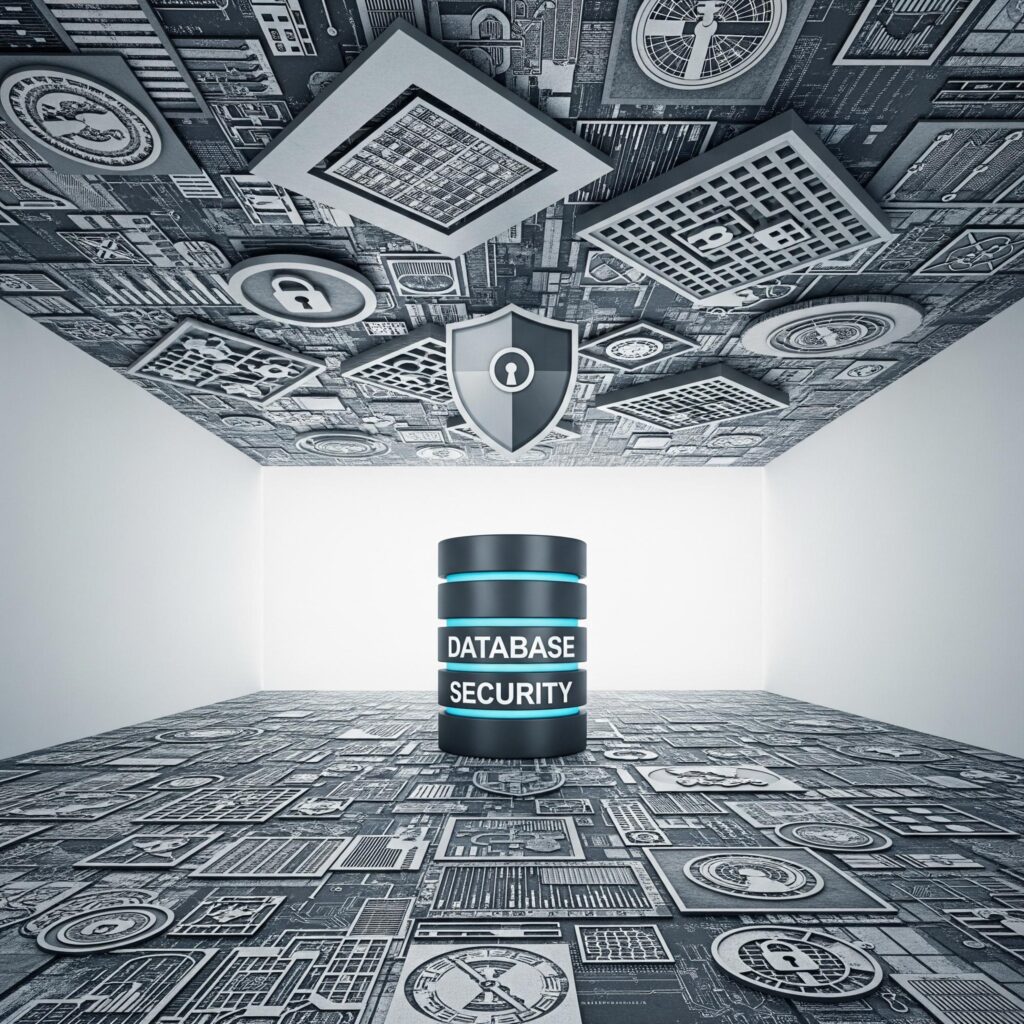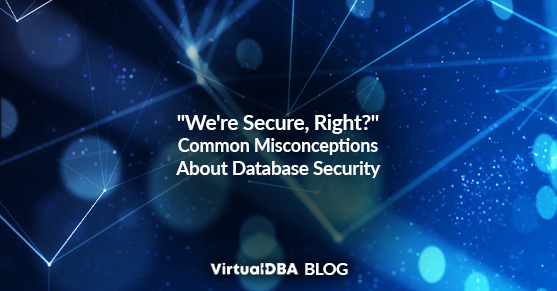SUMMARY:
Many organizations expose their valuable data to significant risk by operating under common database security fallacies. Necessitating specialized technical audits utilizing frameworks like CIS Benchmarks, they can achieve robust protection.
- Infrastructure defenses alone fail to address nuanced database configurations such as user privileges, encryption settings, and object-level access controls.
- Default database configurations often include exposed credentials or overly broad privileges that significantly expand the attack surface if not immediately hardened.
- Compliance with frameworks like PCI DSS does not guarantee comprehensive data security, as rigorous technical controls beyond basic mandates are required to prevent large-scale breaches.
- Database security requires a specialized focus distinct from a DBA’s operational duties. It necessitates independent audits leveraging global standards like CIS Benchmarks to review configurations meticulously.
To eliminate database blind spots and ensure data protection, organizations must move beyond assumptions and implement specialized security audits focused solely on the critical database layer.
Table of contents
- SUMMARY:
- Why General Security Measures Aren’t Enough to Protect Your Database
- Misconception #1: “Our infrastructure is secure, so our database is too.”
- Misconception #2: “Default configurations are ‘secure enough’ for quick deployments.”
- Misconception #3: “Compliance audits cover everything we need for database security.”
- Misconception #4: “Our DBAs handle security; it’s part of their job.”
- The XTIVIA Advantage: Specialized Database Security Audits
- Next Steps: Eliminate Your Database Blind Spots
- Frequently Asked Questions About Database Security Misconceptions
- Q1: How is a specialized database security audit different from a general penetration test?
- Q2: Can’t automated vulnerability scanners detect these database-specific issues?
- Q3: How often should we conduct a specialized database security audit?
- Q4: We use cloud-managed databases (AWS RDS, Azure SQL). Are they inherently more secure?
Why General Security Measures Aren’t Enough to Protect Your Database
It’s a question we hear often, usually accompanied by a nod of confident reassurance: “Our security team has it covered. We’re secure, right?” While that confidence is understandable, especially after investing in robust firewalls, network monitoring, and cloud security platforms, it often masks a critical blind spot: the database itself.
The truth is, many organizations operate under several pervasive misconceptions about database security that can leave their most valuable asset – their data – exposed to significant risk. Let’s peel back the layers of these assumptions and highlight why a specialized, technical approach to database security is not just a nice-to-have, but an absolute necessity.

Misconception #1: “Our infrastructure is secure, so our database is too.”
This is perhaps the most common fallacy. Your perimeter defenses, server hardening, and cloud environment configurations are indeed vital. But consider this: a secured building doesn’t mean the vault inside is automatically impenetrable. DBMS, like Oracle or SQL Server, have distinct architectures, user management, settings, and patch cycles separate from the OS or cloud.
A generic infrastructure scan, while valuable, doesn’t delve into the nuanced configurations of database user privileges, stored procedures, encryption settings (or lack thereof), network listener configurations, or object-level access controls. This is where specialized vulnerabilities hide, often exploited by attackers who have already breached the perimeter.
Example: Equifax Data Breach (2017) – While the initial compromise was through a vulnerability in an Apache Struts web application, the attackers were able to access customer data stored in databases. Even seemingly secure infrastructure can lead to database compromise if an application layer vulnerability isn’t independently hardened and segmented. While attackers didn’t directly attack the database first, its lack of fine-grained access control and monitoring allowed the breach to escalate.
How to Address: This underscores the crucial need for defense-in-depth strategies that explicitly focus on and harden the database layer, treating it as a critical, distinct security domain requiring its own specialized configurations, monitoring, and access controls independent of broader network security.
Misconception #2: “Default configurations are ‘secure enough’ for quick deployments.”
In the rush to deploy new applications or migrate to the cloud, teams often leave default database configurations untouched for convenience. However, these “out-of-the-box” settings are rarely designed for optimal security.Common issues include:
- Default Passwords/Accounts: Many databases ship with well-known default user accounts (e.g., ‘sa’, ‘admin’, ‘root’) with default or easily guessable passwords. If not changed immediately, these become immediate backdoors.
- Broad Privileges: Default user roles might have excessively broad privileges that violate the principle of least privilege. An application user, for instance, rarely needs ‘DBA’ rights.
- Unnecessary Services: Unused database services or network listeners might be enabled by default, expanding the attack surface unnecessarily.
- Weak Encryption: Data encryption might be disabled or configured with weak algorithms, making data vulnerable if intercepted.
Example: MongoDB Ransomware Attacks (2017) – Thousands of MongoDB databases were compromised because they were left publicly exposed on the internet without authentication enabled (a default setting in some older MongoDB versions if not explicitly configured). Attackers scanned for these exposed databases, wiped them, and left a ransom note. This is a stark example of how default, insecure configurations can lead to massive data loss and exposure.
How to Address: Implement proactive security baselines and secure configuration management from day one, ensuring that default credentials are immediately changed, unnecessary services are disabled, and the principle of least privilege is applied to all users and applications before deployment.
Misconception #3: “Compliance audits cover everything we need for database security.”
While compliance frameworks like PCI DSS, HIPAA, and SOX mandate data security controls, they often define what needs to be secured, not how to secure every intricate aspect of a database technically. Achieving compliance requires adherence to specific technical guidelines, such as those provided by CIS Benchmarks.
For example, PCI DSS mandates protection of cardholder data, but it doesn’t specify the exact ALTER SYSTEM SET ENCRYPTION_ALGORITHM = 'AES256' command, or dictate REVOKE SELECT ON sensitive_table FROM public;. Specialized database security audits translate these high-level compliance requirements into actionable, technical configurations, ensuring your database truly aligns with the spirit and letter of regulatory demands.
Example: Target Data Breach (2013) – Despite being PCI DSS compliant, attackers still managed to exfiltrate credit card data from Target. The breach originated through compromised HVAC vendor credentials, but the attackers were able to move laterally within Target’s network and eventually accessed sensitive databases. This incident demonstrated that achieving compliance doesn’t automatically equate to comprehensive security, and technical database security measures beyond basic compliance checks were necessary to prevent such a large-scale breach.
How to Address: View compliance as a floor, not a ceiling. Go beyond basic audit requirements by implementing rigorous technical controls and specialized database hardening (like those found in CIS Benchmarks) to secure data, ensuring both compliance and robust protection truly.

Misconception #4: “Our DBAs handle security; it’s part of their job.”
While skilled DBAs are critical for database performance, availability, and general maintenance, their primary focus isn’t always deep-dive security hardening or staying abreast of the latest exploits specific to database software. Security is a specialized discipline that requires continuous research into vulnerabilities, secure coding practices, and the evolving threat landscape.
A true database security audit goes beyond operational duties, meticulously examining configurations against global best practices like CIS Benchmarks. This ensures that expert eyes, focused solely on security, identify and remediate potential risks that even the most diligent DBA might miss in their day-to-day role.
Example: A Major Retailer’s Database Exposed by Over-privileged Account (Hypothetical Scenario based on common attack vectors) – While not always making national headlines as a direct ‘DBA mistake,’ many breaches are enabled by a lack of independent security review of DBA-granted privileges. Imagine a scenario where a diligent DBA, focused on quickly onboarding a new marketing application, grants its database user broad ‘data writer’ permissions across multiple tables. This might be expedient for the application’s function, but it exceeds the principle of least privilege.
Without a dedicated security audit, separate from the DBA’s operational duties, this over-privileged account becomes a critical vulnerability. If attackers compromise a marketing application (or a developer’s workstation connected to it) via a phishing attack or weak password, they can leverage the excessive database privileges to access and exfiltrate sensitive customer data from tables they weren’t explicitly authorized to see. This highlights how operational efficiency, without a specialized security check, can inadvertently create significant data exposure.
How to Address: Recognize that database security requires a specialized focus, distinct from daily operational DBA tasks. Implement independent security audits and leverage industry-standard frameworks like CIS Benchmarks to ensure all privileges are appropriately managed and reviewed.
The XTIVIA Advantage: Specialized Database Security Audits
At XTIVIA, our Virtual-DBA team understands these misconceptions intimately because we live and breathe database security. We don’t just audit your infrastructure; we dive deep into your databases using the rigorous, consensus-driven CIS Benchmarks. While core security principles apply universally, we understand that each platform—from relational giants like Oracle and SQL Server to NoSQL powerhouses like MongoDB, and open-source solutions like MySQL and PostgreSQL—has its unique security considerations and configuration nuances. Our expertise extends to cloud-managed services like AWS RDS and Azure SQL as well.
Leveraging the Center for Internet Security (CIS) Benchmarks – a globally recognized standard for secure configuration – we apply hundreds of specific controls to fortify your database. This meticulous approach identifies and remediates:
- Misconfigured permissions
- Weak authentication mechanisms
- Insecure network access points
- Improper logging and auditing settings
- Unpatched vulnerabilities
Don’t let assumptions create blind spots in your data security. Partner with XTIVIA to gain a crystal-clear, technical understanding of your database’s true security posture and ensure your most valuable assets are truly protected. Our audits don’t just identify weaknesses; they provide actionable remediation steps, empowering your team to achieve a truly hardened database environment.
Next Steps: Eliminate Your Database Blind Spots
Ready to move beyond assumptions and establish an ironclad defense for your data? Visit our CIS Benchmark and Database Security page to learn how our specialized audits can fortify your entire data stack, provide robust compliance evidence, and give you genuine peace of mind.
Frequently Asked Questions About Database Security Misconceptions
Q1: How is a specialized database security audit different from a general penetration test?
A: A general penetration test often focuses on network and application-level vulnerabilities that could lead to access. A specialized database security audit assumes an attacker has access and focuses on internal database configurations like permissions, encryption, and auditing. It’s about hardening the “vault,” not just testing the perimeter.
Q2: Can’t automated vulnerability scanners detect these database-specific issues?
A: While some scanners offer database checks, they often rely on signature-based detection and may not provide the depth of analysis or context-aware remediation advice that a human expert leveraging comprehensive frameworks like CIS Benchmarks can. Many nuanced configuration weaknesses or policy violations require a deeper understanding of database architecture and business context.
Q3: How often should we conduct a specialized database security audit?
A: It’s recommended to conduct a comprehensive specialized audit at least annually, or after significant changes to your database environment (e.g., major version upgrades, migrations, new application deployments, or after a security incident). Continuous monitoring and smaller, targeted checks are also vital between complete audits.
Q4: We use cloud-managed databases (AWS RDS, Azure SQL). Are they inherently more secure?
A: Cloud providers handle the security of the cloud (the underlying infrastructure, patching of the OS, etc.). However, security in the cloud (your database configurations, user access, data encryption settings, network access groups, etc.) remains your responsibility. CIS Benchmarks also apply to these managed services, ensuring you configure them securely according to best practices.
Check out some otehr database security blogs:

